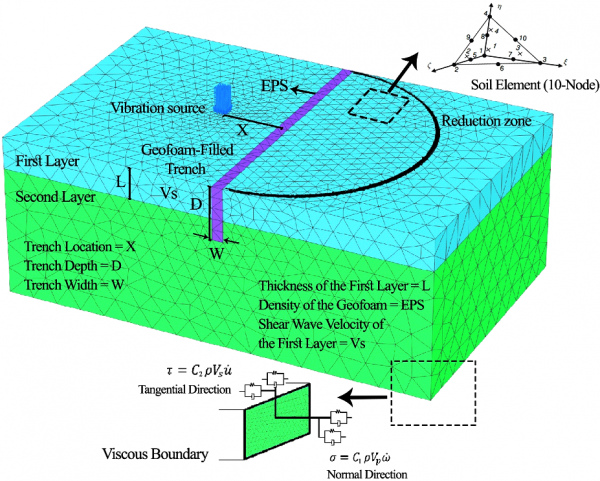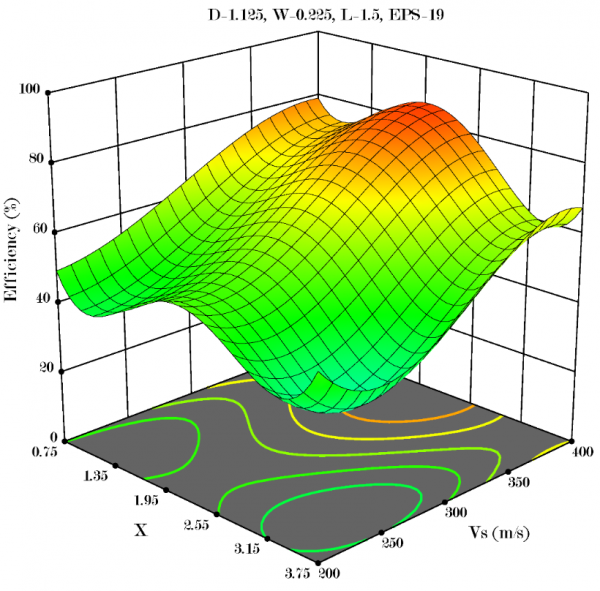
Mehran Naghizadehrokni completed his Master’s degree in geotechnical engineering; his main focus was on a liquefaction topic. Moreover, he worked as a structural engineer and project manager. He obtained a wide range of experiences during his employment and studies, as well. Since summer 2017 he has been employed as a research assistant at the Institute of Geomechanics and Underground Technology at RWTH Aachen University. He managed to submit his dissertation with the main focus on vibration mitigation in three years. The final result of his PhD was an installable application on the computer and mobile to solve the vibration problem. Now he works as a project manager at Arccon Ingenieurgesellschaft MbH, Gelsenkirchen. Here you can find Mehran’s LinkedIn profile.
The path of being a geotechnical engineer
I was raised in a, I would say, “constructional family”. My father had a building supplies shop and my brother is a civil engineer. Since childhood, I was always involved with the construction process of a house and its material. I was always curious about the foundation of a building and how it can tolerate such a heavy load from a big building. Then I decided to answer this curiosity by studying geotechnical engineering. Honestly, I hadn’t any plan to pursue my education until PhD. But here we are, and I’m gonna say, nobody knows what will happen in the future!
After some work experiences in different companies, I decided to maintain a balance between academics and extracurricular activities. Then I decided to start my PhD and as an international researcher, I had to contact several professors in geotechnical engineering. Finally, I could start my PhD at RWTH.
What I am doing as a project manager at arccon company
arccon company, located in Gelsenkirchen, offers engineering services in the fields of geotechnical, environmental and mining engineering as well as in occupational health and safety for private and public clients as well as for industrial customers. This consulting includes, amongst others, national and international construction projects in the field of structural and industrial engineering, transport and power plant construction. My main duty is doing project work in the geotechnical engineering section, including bid processing, supervision of field work and lab tests, report preparation and presentation as well as invoicing.
Screening of vibration through installing a filled barrier
Problem definition
In metropolitan cities, man-made ground vibrations generated by external dynamic sources including traffic, blasting, machine foundations and other constructional activities, have recently become a major concern for the nearby structures and inhabitants. Most of the transmitted vibration energy is propagated by Rayleigh waves close to the soil surface. The rest of the energy is transmitted by body waves. Near-surface vibration can be a major problem for the surrounding buildings and their inhabitants. Therefore, implementing a wave barrier in the transmission path is a suitable solution as it allows scattering the ground-borne vibrations. Fig. 1. shows the vibration isolation problem.

Numerical model and the results
This study presents the performance of geofoam-filled trenches in mitigating of ground vibration transmissions by the means of a comprehensive parametric study. Fig. 2 shows a fully automated 3D numerical model, which is applied to evaluate the screening effectiveness of the trenches in the active and passive schemes.

A usual assumption for the study of ground-borne vibration is considering soil as homogeneous, which is unrealistic. Therefore, it is necessary to find the effect of non-homogeneity of the soil on the efficiency of the geofoam-filled trench. A comprehensive parametric study has been performed automatically by coupling Plaxis and Python under the assumption of treating each parameter as an independent variable. The results showed that some parameters have a considerable impact on each other. Fig. 3 shows the interaction of the shear wave velocity and the location of the soil on the response of the trench. The results show that shear wave velocity and location of the trench have an big impact on the response of the trench in reducing the vibration.

In addition, a genetic algorithm code is presented for optimizing all parameters mutually in homogeneous and non-homogeneous soil. The results showed that non-homogeneous soil requires a deeper trench for reaching the same value of the efficiency as in homogeneous soil.
Artificial neural network model
An Artificial Neural Network (ANN) is a computational model that is inspired based on the structure and functions of biological neural networks in human brains. ANN acts like an artificial human nervous system for receiving, training, and transmitting information. A multilayered feed-forward neural network with a back-propagation training method is developed for predicting the efficiency of the geofoam-filled trench.
The architecture of the developed network includes input, output and two hidden layers with 6, 10, 15 and one neurons, respectively. The optimum number of neurons in each hidden layer is selected based on trial and error method. The structure of the network is fully connected to any nodes in one layer to all other nodes in the next layer and the information only moves forward in the network, from the input to hidden layers and finally to the output node. The input layer receives the features, which are governing parameters for vibration isolation, which are shown in Fig. 1. and the output is corresponded to predict the efficiency of the barrier based on the input layer. The agreement between the results of numerical modelling and the developed models demonstrated the capability of the models in predicting the efficiency of the geofoam-filled trench. Fig. 4. shows the architecture of the developed ANN.

Anti-Vibration App, an advanced solution to solve the vibration problem
Ground-borne vibration is a phenomenon that plays a significant role in the quality of the people’s life in the big cities. A lot of research has been done to improve the knowledge about controlling and predicting the value of the vibration. Advanced finite element model and several experimental tests have been developed to calculate the value of the efficiency of the trench in different situations.
In this project, an App is designed and developed to predict the value of the efficiency and optimize different values for reaching the requested efficiency. Recently, the availability of the data and results of the parametric study have been the interest of researchers for using them for validating the developed model or updating the results. For this purpose, all used data for training an ANN model are attached in the App. Therefore, all results are usable for validating the developed finite element model by other researchers.
The main aim of this App is measuring the efficiency of the installed trench in the non-homogenous soil for mitigating the vibration at ground surface. In summary, the efficiency, which is presented in percentage indicates how successful the trench is in decreasing the value of the vibration. There are some key factors that can influence on the efficiency of the trench including the dimensions of the trench (depth and width), location, material for filling the trench (density of the material) and the properties of the soil (thickness of the first layer of the soil and shear wave velocity of the soil). In conclusion, we have six different parameters for evaluating, which includes, Depth, Width, Location of the trench and Density of the material for filling the trench as well as Thickness and Shear wave velocity of the first layer of the soil. Fig. 5. shows the main page of the developed App. The main advantages of the developed App are:
- Don’t need any Finite Element Program for calculating the efficiency of the trench. The efficiency will be calculated directly with the App
- Predict the value of the vibration in any soil with different parameters
- There is a possibility to import new data to the App, so it can be usable for every researcher in this topic for using Artificial Neural Network and Genetic Algorithm
- This App can be upgraded by other users, too. It means the user can add some sections or create some changes in different section for improving the App
- The App is installable on the computer, android and iOS system

There are four different parts of the developed App. The first part, which is called Plot, presents the result of the parametric study for calculating the efficiency of the geofoam-gilled trench in non-homogeneous soil. The prediction section of the App predicts the efficiency of the geofoam-filled trench in non-homogeneous soil through the developed ANN model and quartic polynomial equation. The optimization section presents the developed couple of genetic algorithm-artificial neural network code for mutual optimization of all parameters. The Neural Network section of the App is available for training new data through ANN model. This model can be used either for vibration isolation or any other topics.
– alle Rechte an Bild und Schrift dieses Beitrags liegen, sofern nicht anders gekennzeichnet, beim Autor –
Wenn auch du Lust hast hier etwas über deine Abschlussarbeit, dein Promotionsthema oder dein Projekt zu schreiben, melde dich gerne bei uns.

